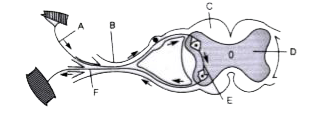The given diagram shows peppered moth in the lichen tree.

(i) What is the picture indicating?
(ii) Write its scientific name.
(iii) In which country did this happen?
iv) Who were the enemies of these moths?
(v) According to Darwin, what was the conclusion of this effect?
Step by step video & image solution for The given diagram shows peppered moth in the lichen tree. (i) What is the picture indicating? (ii) Write its scientific name. (iii) In which country did this happen? iv) Who were the enemies of these moths? (v) According to Darwin, what was the conclusion of this effect? by Biology experts to help you in doubts & scoring excellent marks in Class 10 exams.
Updated on:21/07/2023Topper's Solved these Questions
Similar Questions
Observe the figures given below and then answer the questions that follow :

(i) What is the picture depicting ?
(ii) What was the reason that the giraffe stretched their neck and forelimbs ?
(iii) Name the theory to which this picture belongs.
(iv) Who explained this theory? (V) What is the conclusion of this theory?
View SolutionThe given diagram is to prepare Iron(III) chloride in the laboratory:
(i) What is substance B?
(ii) What is the purpose of B?
(iii) Why is iron(III) chloride to be stored in a closed container?
(iv) Write the equation for the reaction between iron and chlorine.

View SolutionThe given picture shows the face of a Cro-Magnon Man.

(i) What is his scientific name?
(ii) Who discovered the fossil of Cro-Magnon Man ?
(iii) When did they became extinct ?
(iv) Write the characters of the picture shown alongside on the basis of the following:
Height, Body hair, Chin, Posture
View SolutionGiven below is a representation of a type of pollution.
Study the picture and answer the questions :
(i) Name the type of pollution shown in the picture.

(ii) Name one source of this pollution.
(iii) How does this pollution affect human health ?
(iv) Write one measure to reduce this pollution.
(v) State one gaseous compound that leads to the depletion of the ozone layer and creates'Ozone holes'.
View SolutionIn a class, there are 18 girls and 16 boys. The class teacher wants to choose one for class monitor. What she does she writes the name of each on a card and puts them into a basket and mixes thoroughly? A child is asked to pick up one card from the basket. What is the probability that the name written on the card is (i) the name of a girl? (ii) the name of a boy? (iii) the name of topper student of the class? (iv) not ''Shiv Kumar'' who is the son of Principal of this school?
View Solution(a) When a bright silver object is placed in the solution of gold chloride, it acquires a golden tings but nothing happens when it is placed in solution of copper chloride. Explain this behaviour of silver.
[Given : E∘Cu2+/Cu=+0.34V,E∘Ag+/Ag=+0.80V,E∘Au3+/Au=+1.40V]
(b)
Consider the figure given above and answer the following questions :
(i) What is the direction of flow of electrons?
(ii) Which is anode and which is cathode?
(iii) What will happen if the salt bridge is removed ?
(iv) How will concentration of Zn2+ and Ag+ ions be affected when the cell functions ?
(v) How will concentration of these ions be affected when the cell becomes dead ?
View SolutionThe picture given below shows certain vestigial organs of man.

(i) What are vestigial organs ?
(ii) Name the muscles which are shown in the ear.
(iii) What is the name of the third molar ?
(iv) What was the role of vermiform appendix in our ancestors?
(v) What is caudal vertebrae?
View SolutionThe diagram given below is a representation of a phenomenon pertaining to the nervous system. Study the diagram and answer the following questions:

(i) Name the phenomenon that is being depicted.
(ii) Give the technical term for the point of contact between the two nerve cells.
(iii) Name the parts A, B, C and D.
(iv) Write the functions of parts E and F.
(v) How does the arrangement of neurons in the spinal cord differ from that of the brain.
View SolutionGiven below is a diagram of the reproductive system of a human female :

(i) Name the parts numbered 1-6.
(ii) Normally after how many days does an ovary release an egg?
(iii) Where are the sperms released during coitus?
(iv) What do the sperms do after being released ?
(V) What is the function of the organ numbered 5 ?
(vi) How many days does it normally take from the fertilisation of the egg up to the birth of the baby?
View SolutionTwo pendulums C and D suspended from a wire as shown in the figure given below. Pendulum C is made to oscillate by displacing it from its mean position. It is seen that D also starts oscillating.

(i) Name the type of oscillation, C will execute.
(ii) Name the type of oscillation, D will execute.
(iii) If the length of D is made equal to C then what difference will you notice in the oscillations of D?
(iv) What is the name of the phenomenon when the length of D is made equal to C?
View Solution
